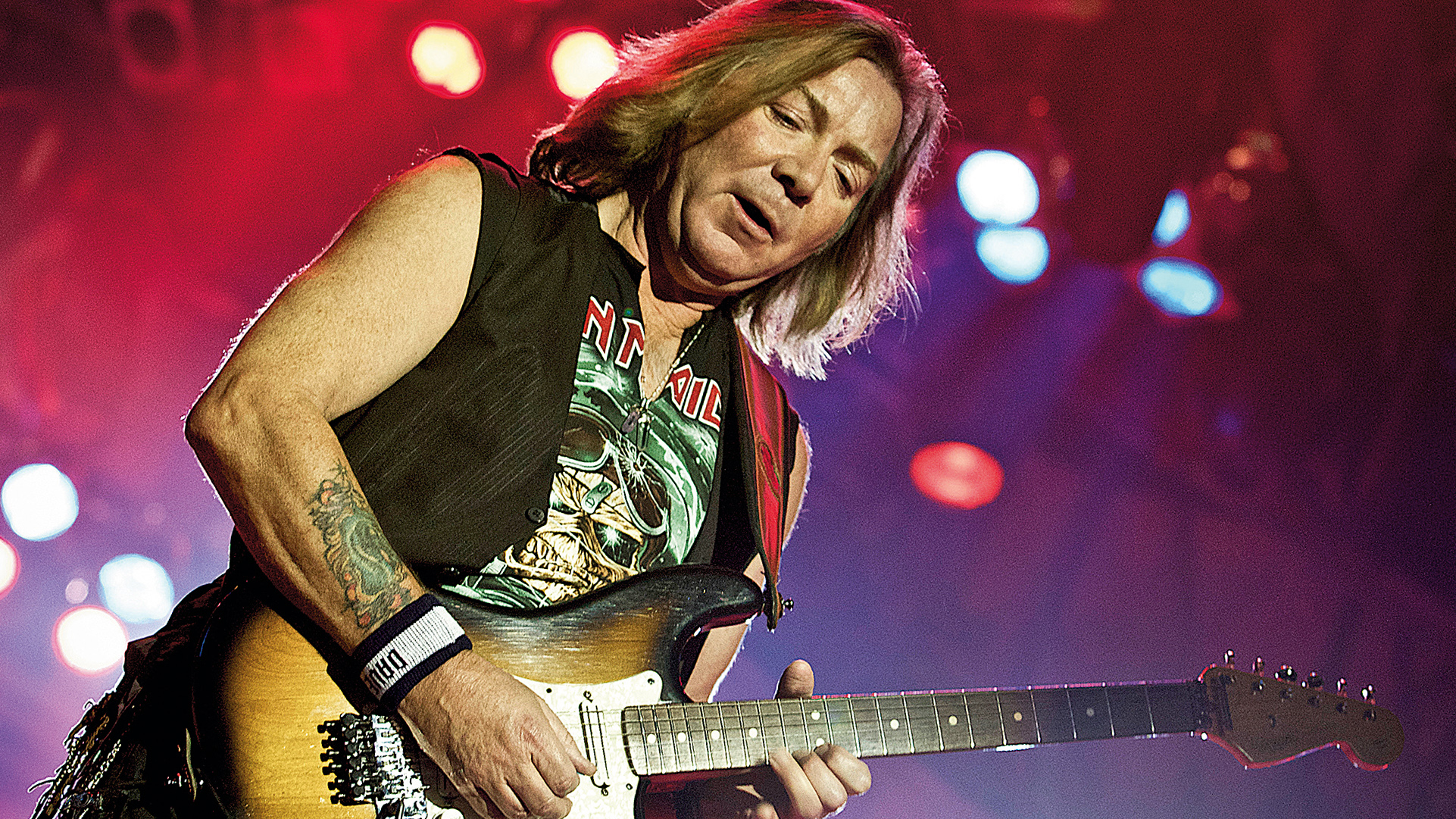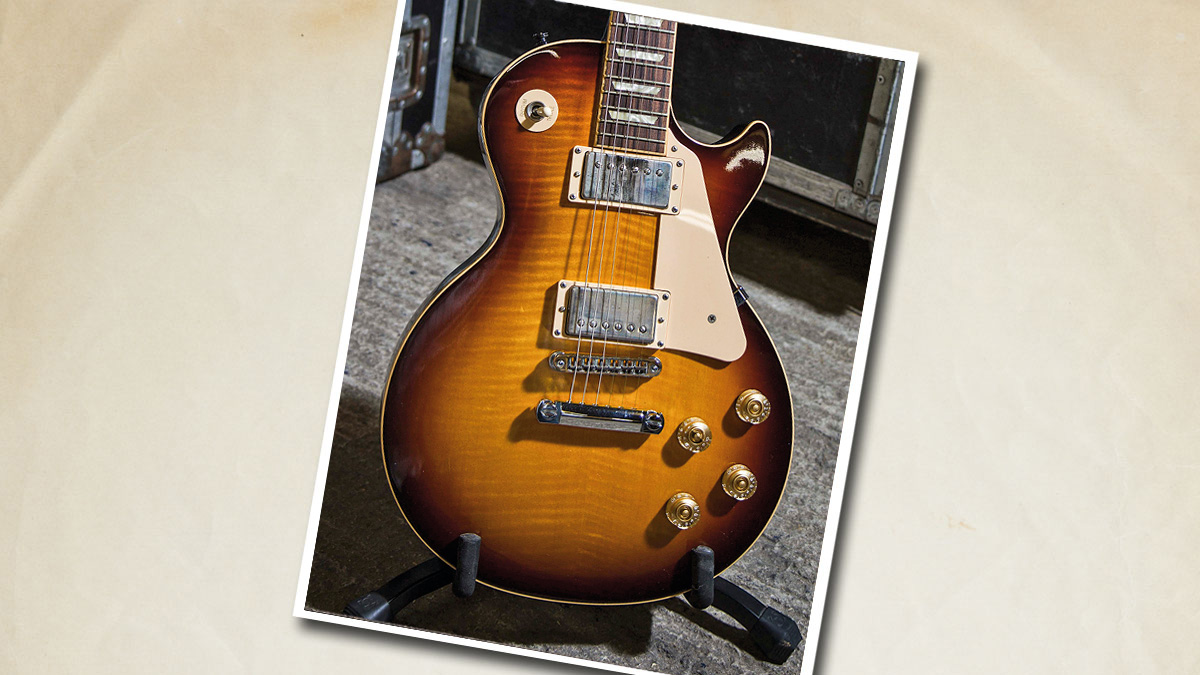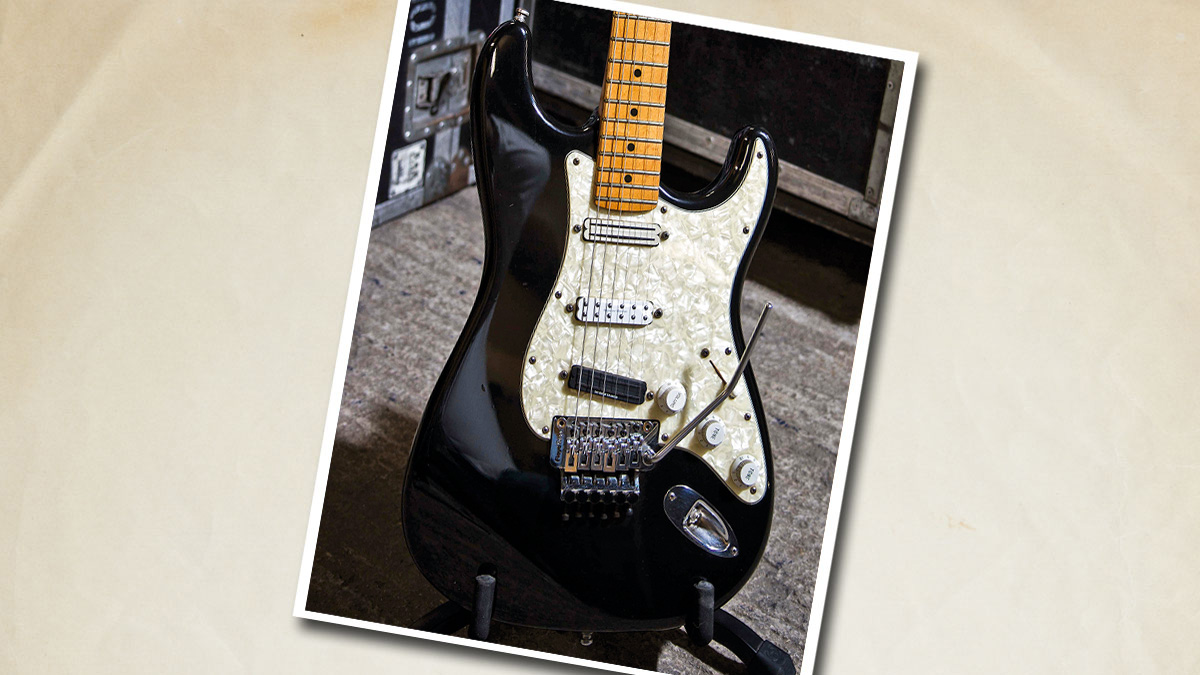
Intro/Tobacco Sunburst Custom Shop Strat
By album number 16, most bands could be forgiven for going through the motions somewhat: phoning it in, mellowing out and resting on the laurels of their past hits from their immense back catalogue.
But Iron Maiden proved some time ago that they’re not ‘most bands’. Metal’s national treasures have just made a 90-minute double album and decided to shake up their creative process in doing so.
Within the maelstrom of creativity on The Book Of Souls are a pair of steady hands belonging to a man whose fluid legato and easy smile are synonymous with the band’s heritage.
Dave Murray has been a cornerstone of Iron Maiden since 1978 (he originally joined, then left, in 1976), first partnering with guitarist Dennis Stratton for the band’s seminal self-titled debut in 1979, then joining up with his childhood friend Adrian Smith for twin harmonies and duelling solos in the greatest creative run of albums ever witnessed in heavy metal.
Janick Gers would eventually replace Smith in 1990, but the latter’s return to the band in 1999 resulted in Maiden’s first ever three‑guitar attack, which saw its debut on 2000’s Brave New World.
That record was recorded at Guillaume Tell Studios in Paris, and for The Book Of Souls, the band once again headed off to the studio, again under the enthusiastic guidance of Joe Bonamassa producer Kevin Shirley – a man who positively encourages the spontaneous spirit Dave is still exploring with Maiden.
Did you surprise yourselves with just how much material you had for this?
“I think we did, really. On previous albums, we’ve usually gone into a rehearsal room for maybe a couple of weeks and maybe have four or five songs under our belts. Then we’d go into the studio and start recording, and the rest of the material would be written while we were there. But this time, we went in there with a blank page and a bunch of ideas.
“After we had several songs and it was over the hour mark anyway, we kind of said, ‘Okay, it looks like it’s going to be a double album…’ It was fantastic, but we stopped there – otherwise we would have been in for three or four albums!”

Gibson 2010 Traditional Series Les Paul
What did such a spontaneous creative process involve?
“Everything was kind of channelled through Steve [Harris, bass]. He would listen to people’s ideas and then he’d start putting pieces together and forming them into shape. We’d learn it and Kevin Shirley would just hit the record button and off we’d go.
"A lot of it was very spontaneous. Maybe we’d just run through it a couple of times and if it had a really good feel, then we’d keep it.
Basically, we were flying by the seat of our pants because we never knew what was coming next
“Other things, obviously the complex sections, took a bit more time to work on, with all the time changes. But it was a really fun experience because it keeps you on your toes. You have to be really sharp.
"We’re scribbling guitar chords down, and melodies and harmonies, changes… Basically, we were flying by the seat of our pants because we never knew what was coming next. Nicko [McBrain, drums] was the one that really had to get it first: the foundation. Afterwards, you go in and patch things up and overdub. But it was wonderful how things kept flowing.”

Kossoff Strat
You wrote the song Man Of Sorrows with Steve. Was that a different kind of collaboration than the way you’ve worked together in the past?
“Over the years, I’d go over to his house or we’d work on songs in a hotel room. But on this album, we gave Steve our ideas on a CD and then he’d take them away, listen to them and maybe rearrange parts. He might write some lyrics and add melodies, but Bruce wrote a lot of the lyrics as well.
"Sometimes, he might leave the whole demo as it was. It’s a good way to collaborate, because sometimes it takes a few listens when you’re showing somebody an idea.
It’s about capturing the performance
“Sometimes, Steve will come up with a [vocal] melody immediately and be inspired that way. Other times, he’ll take stuff back and work on it. Sometimes in the studio you need to go to a quiet spot and sit down and think about things, as opposed to all the distractions that are going on.
"On this album, we gave Steve our ideas and he might splice them up after listening to them back. Then we’d listen back to the reinterpretation, start writing down what the chords were and Nicko would be listening so we could run through it and start recording. It was a lot quicker in terms of putting down the tracks.
"It’s about capturing the performance. But from the original demo idea to the true recorded performance, there are quite a lot of changes that occur.”
When you, Adrian and Janick go in to track your guitar solos on songs like The Red And The Black, do you listen to what each other has done before you respond with your own solo?
“If one of the other guys is doing a solo, maybe you’ll hear a bit of it during the playback, but usually, you’ll cut in three or four seconds before your solo starts and just jump in. But you won’t really hear anything [much], so I was pleasantly surprised when I heard the album – what Adrian and Janick had played that I hadn’t heard before – because we’d go in individually with Kevin and work on little parts like that. So it’s exciting to hear the finished product.”

2002 1960 Series Iced Tea Les Paul Classic
Your solos have an especially instinctive feel on this album. Do you find your first take is often your strongest?
“Yes, definitely. That always tends to be the case, because it’s fresh and spontaneous. On this album, I didn’t really go in with any preconceived ideas; I didn’t work anything out in the hotel or anything. I was just kind of ‘go for it’ on most of the album. So I’d play some stuff and Kevin would say, ‘Yes, that sounds good.’
"And sometimes it would be the first take, then other times, I’d do two or three different things and then go out and have a cup of coffee and Kevin would put all the bits together. Then I’d come back and listen to it and he’d ask, ‘What do you think of that?’
“Then you have to go back and learn it for the tour. But that’s what the studio is for. The thing about editing and cutting pieces together is it can be done seamlessly now.
"Working with Kevin is great because his enthusiasm rubs off. You’re sitting in the control room next to him and he’s really excited and he’s really into it. He tends to bring out the best in everyone in the whole band, individually as well.
There’s no hard and fast rules to the way we do things. If it sounds good and if we like it, we keep it
“The rule of thumb is generally that the first take is the best. You could go on and play something that may be technically better, but it loses the feel.
"There’s no hard and fast rules to the way we do things. If it sounds good and if we like it, we keep it. If not, it just goes on the cutting room floor to magnetic heaven! But sometimes, it’s been a case of doing two or three passes and you decide which one is better.”
Do you trust your instincts more with solos now compared to the old days?
“I think I’ve always tried to be more spontaneous, but there were a few albums where I meticulously worked out everything before I went in: solos, melodies… I’d sit down and go over them.
"A few sections we’ve done, I’ve had to consciously sit down and work out because some of the chord sections were weird to play over – maybe jazzy – and it’d force me to go to places I wouldn’t normally go, which is healthy. I’ve tried to be spontaneous as much as possible.
"But sometimes you do have to sit down and consciously work out something, and then you can experiment.”

Gibson 2004 Flying V
There’s a bit more wah than usual for Maiden on this record…
“I think, listening back, there’s quite a lot of wah pedal on this album [a Dunlop Cry Baby]. We were breaking out the wah and the [Fulltone] DejáVibe. It’s nice to have a bit of delay, too, [Dave used a TC Electronic Flashback] because, in the studio, it can be really dry and you want to feel you are in a live situation where you have that hall echo that you can play off.
"So we’re not afraid of using effects. Back in the 80s, you’d probably hear a lot more chorus in Maiden songs. Now, there’s less and it’s back to being more raw. Sometimes, it’s all about what you leave out.”
15 years in, how do you think Adrian, Janick and yourself have embraced the three-guitar sound?
“It’s nice that we can have three-guitar harmonies now, especially in a live situation. It’s been a natural evolution. When the three of us started playing together, we’d be playing the same chords but on different parts of the neck, and one of us might play clean while another plays something heavy.
It’s teamwork when we play together, and it’s orchestrated that way. I think we inspire each other
"We don’t work at it that hard, but we sit down to make sure the intonation is there and it sounds good, that we’re not clashing. But most of the time, it works out very naturally.
"We’ll work out the intricate parts and nuances in the harmonies. It doesn’t necessarily mean it’s heavier because you’ve got three guitars, but it’s become more musical. It’s teamwork when we play together, and it’s orchestrated that way. I think we inspire each other.
“When Janick, Adrian and I sit down and are working things out it’s done very quietly – almost acoustically, playing in unison. It’s definitely inspirational, because they’re great players and they really go for it.”
When Iron Maiden make a new album, you really commit to supporting it in your live set. But, also, every few years, you’ve done something retrospective in your setlists, too. Do you think you’ve found the best of both worlds?
“Well, every few years, we’ve recorded a new album and then we’ve purposefully gone out on tour with it. Over the years, we’ve had so many songs to choose from that it gets harder and harder each time. For the next tour, we’ll be taking songs from The Book Of Souls out there, but also reflecting back on the past 30 years – and a lot of kids want to hear the older material as well as the new stuff.
Bruce has always been the fittest and strongest guy in the band anyway
“But doing a new album keeps us current and valid – it’s not just about playing the old songs. So it’s rewarding to go out and play the new songs, but by the same token, it’s also comfortable and fantastic when we’re playing the old stuff.
"There are a lot of memories there. But the new songs do keep you on your toes, so you’ve got to make sure you’ve got them well locked down before you go on stage.”
Completing this double album, and with Bruce Dickinson getting back to health, does Iron Maiden feel stronger than ever?
“When we were recording, Bruce had done the whole album and he was absolutely fine. So when we heard [Bruce was diagnosed with a cancerous tumour at the back of his tongue in late 2014], obviously, we were all in shock. But we knew the prognosis was positive and he was going to heal.
"Once we heard, we put everything on hold and when we got the news that he was fine, up and about – and he’s in tip-top shape right now – we were able to move forward and go back out on tour. The band is stronger than ever, and Bruce has always been the fittest and strongest guy in the band anyway. We’ve got no problem touring this album next year.
"We’re not over the hill, but when you are over the hill, you just go faster!”

HHH Dave Murray signature Strat
Fender recently released a new HHH Dave Murray Strat in Two-Colour Sunburst. Dave explains the original that inspired it, and the change that made it even more essential as a live guitar for Maiden.
“I had my custom Fender Strat made about 15 years ago, and it had the Seymour Duncan Hot Rails in it. Then Colin, my guitar tech, suggested putting the Seymour Duncan JB Jr in the middle position to get more of a cleaner, jangly kind of sound. And it worked fantastically.
"I’ll have it in the five-way position set in the middle of the Hot Rails, and it gives a nice clean tone. With the Maiden material, although there’s a lot of heavy chord tones, there’s also a lot of cleans in between, so that Strat works perfectly.
"For what we’re doing, you can switch from a heavy part quickly to a clean at the push of a button. Because things are happening so quickly sometimes, you don’t have time to think, you have to act spontaneously.”

Rob is the Reviews Editor for GuitarWorld.com and MusicRadar guitars, so spends most of his waking hours (and beyond) thinking about and trying the latest gear while making sure our reviews team is giving you thorough and honest tests of it. He's worked for guitar mags and sites as a writer and editor for nearly 20 years but still winces at the thought of restringing anything with a Floyd Rose.

